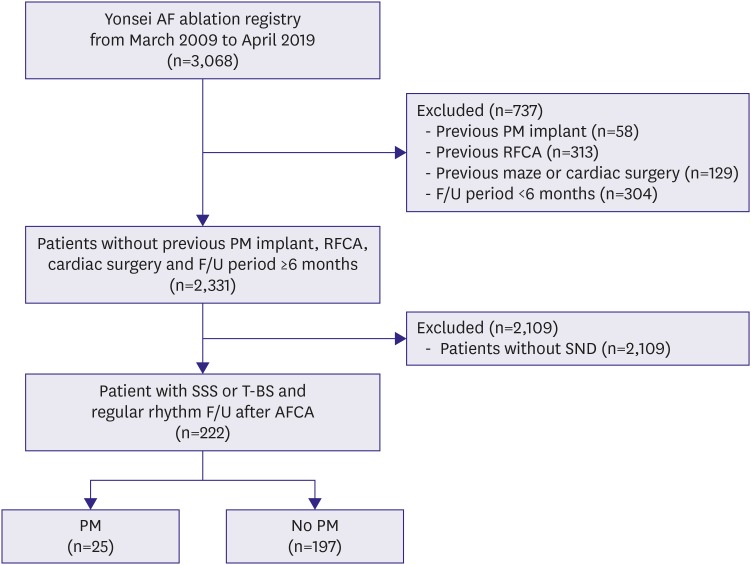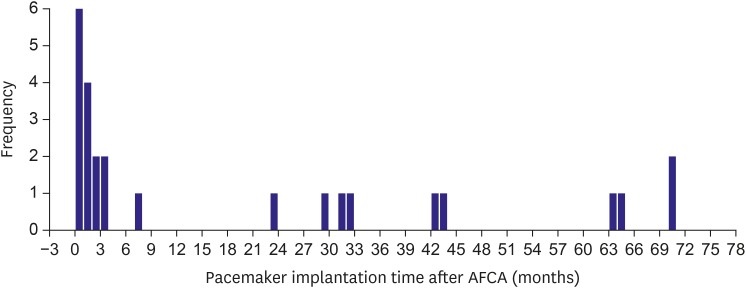Korean Circ J.
2020 Apr;50(4):346-357. 10.4070/kcj.2019.0268.
Permanent Pacemaker Implantations after Catheter Ablation in Patients with Atrial Fibrillation Associated with Underlying Sinus Node Dysfunction
- Affiliations
-
- 1Department of Cardiology, Yonsei University Health System, Seoul, Korea. hnpak@yuhs.ac
- KMID: 2471285
- DOI: http://doi.org/10.4070/kcj.2019.0268
Abstract
- BACKGROUND AND OBJECTIVES
The objective of this study was to evaluate the long-term clinical outcomes and the incidence of permanent pacemaker implantation after catheter ablation in patients with of atrial fibrillation (AF) and sinus node dysfunction (SND).
METHODS
Among 3,068 total consecutive patients who underwent AF catheter ablation (AFCA), this study included 222 (9.5%; men 53.2%, 63.7±9.2 years of age, 81.5% paroxysmal AF) with underlying SND and a regular rhythm follow-up. We analyzed the rhythm outcomes, changes in the mean heart rate or heart rate variability, and permanent pacemaker implantation rate.
RESULTS
During 47.5±28.8 months of follow-up, 25 (11.3%) patients received pacemaker implantations due to symptomatic SND. More than half (56.0%, 14/25) underwent a pacemaker implantation within 3 months of the AFCA, and the annual pacemaker implantation rate was 2.0% afterwards. Both the early (68.0% vs. 31.0%, p<0.001) and clinical AF recurrence (68.0% vs. 32.5%, p=0.001) rates and continuous antiarrhythmic drug use after 3 months (44.0% vs. 24.4%, p=0.036) were significantly higher in patients requiring pacemaker implantations than those that did not. An anterior linear ablation (odds ratio [OR], 9.37 [3.03-28.9]; p<0.001) and the E/Em (OR, 1.15 [1.02-1.28]; p=0.018) were independently associated with permanent pacemaker implantations after AFCA in patients with AF and SND.
CONCLUSIONS
After AFCA in patients with AF and SND, 1 of 9 patients needed a pacemaker implantation and half needed implantations within 3 months. The AF recurrence rate was significantly higher in those who required pacemaker implantations after the AFCA.
MeSH Terms
Figure
Cited by 2 articles
-
External Electrical Cardioversion is an Easy and Safe Intervention for Rhythm Control in Persistent Atrial Fibrillation
Chang Hee Kwon
Korean Circ J. 2020;50(6):524-526. doi: 10.4070/kcj.2020.0122.Prophylactic Cavotricuspid Isthmus Ablation in Patients without Typical Atrial Flutter: End of the Line
Eue-Keun Choi
Korean Circ J. 2020;51(1):65-67. doi: 10.4070/kcj.2020.0417.
Reference
-
1. Nielsen JC, Thomsen PE, Højberg S, et al. A comparison of single-lead atrial pacing with dual-chamber pacing in sick sinus syndrome. Eur Heart J. 2011; 32:686–696. PMID: 21300730.2. Lamas GA, Lee K, Sweeney M, et al. The mode selection trial (MOST) in sinus node dysfunction: design, rationale, and baseline characteristics of the first 1000 patients. Am Heart J. 2000; 140:541–551. PMID: 11011325.3. Chang HY, Lin YJ, Lo LW, et al. Sinus node dysfunction in atrial fibrillation patients: the evidence of regional atrial substrate remodelling. Europace. 2013; 15:205–211. PMID: 22772055.4. Hocini M, Sanders P, Deisenhofer I, et al. Reverse remodeling of sinus node function after catheter ablation of atrial fibrillation in patients with prolonged sinus pauses. Circulation. 2003; 108:1172–1175. PMID: 12952840.5. Chen YW, Bai R, Lin T, et al. Pacing or ablation: which is better for paroxysmal atrial fibrillation-related tachycardia-bradycardia syndrome? Pacing Clin Electrophysiol. 2014; 37:403–411. PMID: 24456243.6. Kirchhof P, Benussi S, Kotecha D, et al. 2016 ESC guidelines for the management of atrial fibrillation developed in collaboration with EACTS. Eur Heart J. 2016; 37:2893–2962. PMID: 27567408.7. Kusumoto FM, Schoenfeld MH, Barrett C, et al. 2018 ACC/AHA/HRS guideline on the evaluation and management of patients with bradycardia and cardiac conduction delay: a report of the American College of Cardiology/American Heart Association Task Force on Clinical Practice Guidelines and the Heart Rhythm Society. Circulation. 2019; 140:e382–482. PMID: 30586772.8. Calkins H, Kuck KH, Cappato R, et al. 2012 HRS/EHRA/ECAS expert consensus statement on catheter and surgical ablation of atrial fibrillation: recommendations for patient selection, procedural techniques, patient management and follow-up, definitions, endpoints, and research trial design: a report of the Heart Rhythm Society (HRS) Task Force on Catheter and Surgical Ablation of Atrial Fibrillation. Developed in partnership with the European Heart Rhythm Association (EHRA), a registered branch of the European Society of Cardiology (ESC) and the European Cardiac Arrhythmia Society (ECAS); and in collaboration with the American College of Cardiology (ACC), American Heart Association (AHA), the Asia Pacific Heart Rhythm Society (APHRS), and the Society of Thoracic Surgeons (STS). Endorsed by the governing bodies of the American College of Cardiology Foundation, the American Heart Association, the European Cardiac Arrhythmia Society, the European Heart Rhythm Association, the Society of Thoracic Surgeons, the Asia Pacific Heart Rhythm Society, and the Heart Rhythm Society. Heart Rhythm. 2012; 9:632–696.e21. PMID: 22386883.9. Lee JY, Kim TH, Yang PS, et al. Korean atrial fibrillation network genome-wide association study for early-onset atrial fibrillation identifies novel susceptibility loci. Eur Heart J. 2017; 38:2586–2594. PMID: 28460022.10. Wang J, Klysik E, Sood S, Johnson RL, Wehrens XH, Martin JF. Pitx2 prevents susceptibility to atrial arrhythmias by inhibiting left-sided pacemaker specification. Proc Natl Acad Sci U S A. 2010; 107:9753–9758. PMID: 20457925.11. Lamas GA, Lee KL, Sweeney MO, et al. Ventricular pacing or dual-chamber pacing for sinus-node dysfunction. N Engl J Med. 2002; 346:1854–1862. PMID: 12063369.12. Elvan A, Wylie K, Zipes DP. Pacing-induced chronic atrial fibrillation impairs sinus node function in dogs. Electrophysiological remodeling. Circulation. 1996; 94:2953–2960. PMID: 8941126.13. Yeh YH, Burstein B, Qi XY, et al. Funny current downregulation and sinus node dysfunction associated with atrial tachyarrhythmia: a molecular basis for tachycardia-bradycardia syndrome. Circulation. 2009; 119:1576–1585. PMID: 19289641.14. Sparks PB, Jayaprakash S, Vohra JK, Kalman JM. Electrical remodeling of the atria associated with paroxysmal and chronic atrial flutter. Circulation. 2000; 102:1807–1813. PMID: 11023936.15. Cha TJ, Ehrlich JR, Zhang L, et al. Dissociation between ionic remodeling and ability to sustain atrial fibrillation during recovery from experimental congestive heart failure. Circulation. 2004; 109:412–418. PMID: 14718405.16. Yu HT, Kim TH, Uhm JS, et al. Prognosis of high sinus heart rate after catheter ablation for atrial fibrillation. Europace. 2017; 19:1132–1139. PMID: 27256421.17. Cho MS, Heo R, Jin X, et al. Sick sinus syndrome after the maze procedure performed concomitantly with mitral valve surgery. J Am Heart Assoc. 2018; 7:e009629. PMID: 30371317.18. Hayashi K, Fukunaga M, Yamaji K, et al. Impact of catheter ablation for paroxysmal atrial fibrillation in patients with sick sinus syndrome - important role of non-pulmonary vein foci -. Circ J. 2016; 80:887–894. PMID: 26936115.19. Morton JB, Sanders P, Vohra JK, et al. Effect of chronic right atrial stretch on atrial electrical remodeling in patients with an atrial septal defect. Circulation. 2003; 107:1775–1782. PMID: 12665497.20. Park J, Joung B, Uhm JS, et al. High left atrial pressures are associated with advanced electroanatomical remodeling of left atrium and independent predictors for clinical recurrence of atrial fibrillation after catheter ablation. Heart Rhythm. 2014; 11:953–960. PMID: 24607916.21. Pak HN, Oh YS, Lim HE, Kim YH, Hwang C. Comparison of voltage map-guided left atrial anterior wall ablation versus left lateral mitral isthmus ablation in patients with persistent atrial fibrillation. Heart Rhythm. 2011; 8:199–206. PMID: 20950713.
- Full Text Links
- Actions
-
Cited
- CITED
-
- Close
- Share
- Similar articles
-
- A case of sinus node dysfunction and atrial tachycardia after the excision of a left atrial myxoma
- Catheter Ablation is Effective for Recovery from Sinus Node Dysfunction in Patients with Atrial Fibrillation, But Close Monitoring is Still Needed
- A single‑center outcome of choosing catheter ablation as the initial treatment in tachycardia–bradycardia syndrome and a new predictive factor for pacemaker implantation
- The Mechanism of and Preventive Therapy for Stroke in Patients with Atrial Fibrillation
- A Case of Successful Ablation of Right-Sided Accessory Pathway during Atrial Fibrillation




